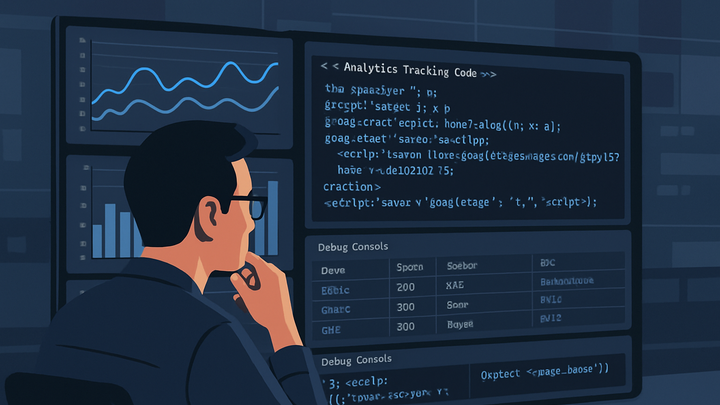Published on 2025-06-22T02:58:41Z
What is Debugging in Analytics? Examples for GA4 and PlainSignal
In analytics, debugging is the process of systematically identifying, diagnosing, and resolving issues in your data collection and tracking setup. Whether it’s missing events, incorrect parameters, or unexpected anomalies, debugging helps ensure your insights are based on accurate information. Commonly used in platforms like Google Analytics 4 (GA4) and PlainSignal, debugging involves validating that tracking scripts fire correctly, that event payloads contain the intended data, and that configuration settings are properly applied. Debugging workflows leverage real-time tools such as DebugView, browser developer tools, and network inspection to observe events as they happen. By proactively debugging your analytics implementation, you safeguard data integrity and maintain trustworthiness in your reporting and decision-making processes.
Debugging
Systematic process of finding and fixing issues in analytics tracking for accurate data collection.
Overview of Debugging in Analytics
An introduction to what debugging means in the context of analytics implementations.
-
Definition
Debugging in analytics refers to the practice of inspecting and fixing errors or misconfigurations in your data collection setup to ensure accuracy.
-
Goals of debugging
Ensure that all tracking events fire as expected, parameters are captured correctly, and data pipelines reflect true user interactions.
Key Debugging Tools and Methods
Overview of the primary tools and techniques used to debug analytics setups across different platforms.
-
Real-time debugview
Platforms like GA4 and PlainSignal offer real-time views to monitor events as they are sent.
-
GA4 debugview
Activate DebugView in GA4 by enabling debug mode or appending
?gtm_debug=xto your URL to see events in real time. -
PlainSignal live mode
Use PlainSignal’s live event monitoring to observe data on the dashboard instantly without cookies.
-
-
Browser developer tools
Use Chrome DevTools or similar to inspect network requests and console logs.
-
Inspect network requests
Open DevTools, go to the Network tab, filter by analytics domains (
google-analytics.com,plainsignal.com), and check request payloads and response codes. -
Console logging
Add
console.logstatements before and after analytics calls to verify that functions execute and parameters pass correctly.
-
-
Tagging and datalayer validation
Check that your tags and DataLayer pushes are structured and firing correctly.
-
Google tag assistant
Use the Tag Assistant browser extension to verify that your GTM or analytics tags are firing without errors.
-
Datalayer inspection
Inspect the
dataLayerarray in the console to ensure it contains expected variables and event data.
-
Step-by-Step Debugging Process
A recommended workflow to systematically debug your analytics implementation.
-
Verify implementation
Confirm that the tracking snippets are present, correctly placed, and reference the right IDs and domains.
-
Snippet verification
Ensure your
<link>and<script>tags are in the<head>or just before</body>as documented. -
Attribute checks
Verify that attributes like
data-do,data-id, anddata-apimatch your PlainSignal setup, and that GA4 IDs are correct.
-
-
Enable debugging mode
Turn on debug mode to surface verbose logs and real-time events.
-
GA4 debug mode
Set
gtag('set', {'debug_mode': true});or use the Google Tag Manager preview mode to view debug events. -
PlainSignal test mode
Run PlainSignal in development mode or use the provided live preview to see incoming events without caching.
-
-
Monitor incoming events
Use platform-specific dashboards to verify that events arrive as intended.
-
GA4 realtime reports
Navigate to Realtime > Events in the GA4 interface to watch events flow in.
-
PlainSignal dashboard
Open the live view in PlainSignal’s dashboard to confirm event names, properties, and counts.
-
Examples of Debugging Analytics Code
Concrete code snippets and checks for both PlainSignal and GA4 implementations.
-
PlainSignal tracking code
Embed and verify the PlainSignal snippet on your site.
-
Embed snippet
<link rel="preconnect" href="//eu.plainsignal.com/" crossorigin /> <script defer data-do="yourwebsitedomain.com" data-id="0GQV1xmtzQQ" data-api="//eu.plainsignal.com" src="//cdn.plainsignal.com/plainsignal-min.js"></script> -
Network request check
In DevTools, filter network requests for
eu.plainsignal.comand confirm a 200 status and correct payload structure.
-
-
GA4 gtag.js snippet
Standard GA4 implementation and enabling debug mode.
-
Embed snippet
<!-- Google tag (gtag.js) --> <script async src="https://www.googletagmanager.com/gtag/js?id=G-XXXXXXX"></script> <script> window.dataLayer = window.dataLayer || []; function gtag(){dataLayer.push(arguments);} gtag('js', new Date()); gtag('config', 'G-XXXXXXX'); </script> -
Enable debug mode
Add
gtag('set', {'debug_mode': true});after your config call to view detailed logs in the console.
-
Troubleshooting Common Issues
Frequent pitfalls and how to resolve them.
-
No data appearing
Steps to take when events are not showing up in your analytics platform.
-
Network errors
Look for 4xx or 5xx status codes in DevTools that indicate the request failed.
-
Blocked requests
Check if ad blockers, browser privacy settings, or CSP rules are preventing analytics domains from loading.
-
Incorrect ids
Ensure the measurement ID (GA4) or project ID (PlainSignal) matches your account.
-
-
Data discrepancies
Resolving mismatches between different analytics tools or reporting views.
-
Time zone settings
Verify that both platforms use the same time zone to avoid offset issues.
-
Sampling
Understand that GA4 may sample data under heavy load while PlainSignal uses a streaming model.
-
Filters and exclusions
Review any filters, views, or audience exclusions that might omit valid traffic.
-
